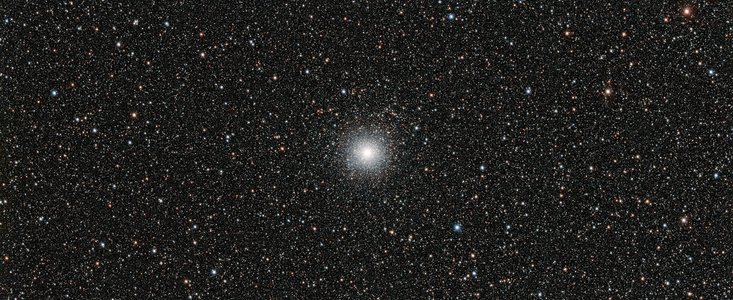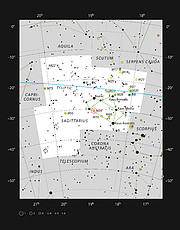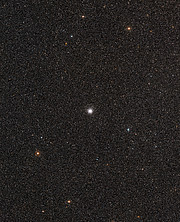Komunikat prasowy
Gromada gwiazd nie jest taka, jakby się wydawało
Wniosek z obserwacji gromady Messier 54 za pomocą VLT: problem z litem występuje także poza naszą galaktyką
10 września 2014
Na nowym zdjęciu z teleskopu VST (VLT Survey Telescope) w Obserwatorium Paranal w północnym Chile widać wielki zbiór gwiazd – gromadę kulistą Messier 54. Gromada wygląda bardzo podobnie do wielu innych, ale skrywa pewien sekret. Messier 54 nie należy do Drogi Mlecznej, jest natomiast częścią małej satelitarnej Galaktyki Karłowatej w Strzelcu. To nietypowe umiejscowienie pozwoliło astronomom wykorzystać teleskop VLT (Very Large Telescope – Bardzo Duży Teleskop) do sprawdzenia czy w gwiazdach poza Drogą Mleczną także występują nieoczekiwanie małe poziomy pierwiastka litu.
Drogę Mleczną okrąża około 150 gromad kulistych gwiazd, które są kulami złożonymi z setek tysięcy starych gwiazd z czasów początków powstawania galaktyki. Jedna z gromad została dostrzeżona wraz z kilkoma innymi w konstelacji Strzelca pod koniec osiemnastego wieku przez francuskiego łowcę komet Charlesa Messiera. Obiekt otrzymał oznaczenie Messier 54.
Przez ponad dwieście lat od odkrycia uważano, że gromada Messier 54 jest podobna do innych gromad kulistych w Drodze Mlecznej. Ale w 1994 roku odkryto, że w rzeczywistości jest powiązana z inną galaktyką – Galaktyką Karłowatą w Strzelcu. Dystans do gromady wynosi 90 000 lat świetlnych, czyli ponad trzy razy dalej niż z Ziemi do centrum Galaktyki.
Astronomowie zaobserwowali niedawno gromadę Messier 54 za pomocą VLT, aby sprawdzić jedną z zagadek współczesnej astronomii – problem litu.
Większość lekkiego pierwiastka litu obecnie występująca we Wszechświecie została wyprodukowana podczas Wielkiego Wybuchu. Podobnie jak wodór i hel, tylko w znacznie mniejszych ilościach. Astronomowie potrafią całkiem dokładnie obliczyć ile litu powinno występować we wczesnym Wszechświecie, a na tej podstawie określić ile powinno go być w starych gwiazdach. Ale liczby się nie zgadzają – w gwiazdach występuje około trzy razy mniej litu niż powinno. Ta zagadka nadal jest nierozwiązana pomimo kilkudziesięciu lat badań [1].
Do tej pory można było mierzyć lit w gwiazdach tylko w Drodze Mlecznej. Niedawno zespół astronomów kierowany przez Alessio Mucciarelliego (University of Bologna, Włochy) wykorzystał teleskop VLT do zmierzenia ilości litu w wybranych gwiazdach gromady Messier 54. Okazało się, ze poziomy litu są bliskie tym w Drodze Mlecznej. Zatem cokolwiek spowodowało małą zawartość litu, nie jest to cecha specyficzna dla naszej Galaktyki.
Nowe zdjęcie gromady zostało utworzone zdanych zebranych za pomocą teleskopu VST (VLT Survey Telescope) w Obserwatorium Paranal. Oprócz samej gromady widać na pierwszym planie bardzo gęsty las znacznie bliższych gwiazd Drogi Mlecznej.
Uwagi
[1] Istnieje kilka możliwych propozycji rozwiązań zagadki. Pierwsze rozwiązanie – obliczenia ilości litu wytworzonego podczas Wielkiego Wybuchu są błędne, jednak najnowsze testy sugerują, że to nie jest właściwe wytłumaczenie. Druga propozycja – lit był w jakiś sposób niszczony w najwcześniejszych gwiazdach, zanim powstała Droga Mleczna. Trzecia koncepcja – jakiś proces w gwiazdach stopniowo niszczy lit.
Więcej informacji
Wyniki badań zaprezentowano w artykule pt. “The cosmological Lithium problem outside the Galaxy: the Sagittarius globular cluster M54”, A. Mucciarelli et al., który ukaże się w Monthly Notices of the Royal Astronomical Society (Oxford University Press).
Skład zespołu badawczego: A. Mucciarelli (University of Bologna, Włochy), M. Salaris (Liverpool John Moores University, Liverpool, Wielka Brytania), P. Bonifacio (Observatoire de Paris, Francja), L. Monaco (ESO, Santiago, Chile) oraz S. Villanova (Universidad de Concepcion, Concepcion, Chile).
ESO jest wiodącą międzyrządową organizacją astronomiczną w Europie i najbardziej produktywnym obserwatorium astronomicznym na świecie. Jest wspierane przez 15 krajów: Austria, Belgia, Brazylia, Czechy, Dania, Finlandia, Francja, Hiszpania, Holandia, Niemcy, Portugalia, Szwajcaria, Szwecja, Wielka Brytania oraz Włochy. ESO prowadzi ambitne programy dotyczące projektowania, konstrukcji i użytkowania silnych naziemnych instrumentów obserwacyjnych, pozwalając astronomom na dokonywanie znaczących odkryć naukowych. ESO odgrywa wiodącą rolę w promowaniu i organizowaniu współpracy w badaniach astronomicznych. ESO zarządza trzema unikalnymi, światowej klasy obserwatoriami w Chile: La Silla, Paranal i Chajnantor. W Paranal ESO posiada Bardzo Duży Teleskop (Very Large Telescope), najbardziej zaawansowane na świecie astronomiczne obserwatorium w świetle widzialnym oraz dwa teleskopy do przeglądów. VISTA pracuje w podczerwieni i jest największym na świecie instrumentem do przeglądów nieba, natomiast VLT Survey Telescope to największy teleskop dedykowany przeglądom nieba wyłącznie w zakresie widzialnym. ESO jest europejskim partnerem dla rewolucyjnego teleskopu ALMA, największego istniejącego projektu astronomicznego. ESO planuje obecnie 39-metrowy teleskop E-ELT (European Extremely Large optical/near-infrared Telescope - Ekstremalnie Wielki Teleskop Europejski), który stanie się “największym okiem świata na niebo”.
Kontakt
Krzysztof Czart
Centrum Astronomii UMK
Toruń, Polska
Tel.: +48 513 733 282
E-mail: eson-poland@eso.org
Alessio Mucciarelli
University of Bologna
Bologna, Italy
Tel.: +39 051 20 95705
E-mail: alessio.mucciarelli2@unibo.it
Lars Lindberg Christensen
Head of ESO ePOD
Garching bei München, Germany
Tel.: +49 89 3200 6761
Tel. kom.: +49 173 3872 621
E-mail: lars@eso.org
O komunikacie
| Komunikat nr: | eso1428pl |
| Nazwa: | M 54 |
| Typ: | Milky Way : Star : Grouping : Cluster : Globular |
| Facility: | VLT Survey Telescope |
| Instrumenty: | OmegaCAM |
| Science data: | 2014MNRAS.444.1812M |





